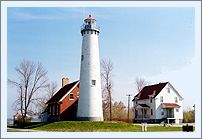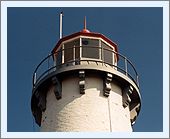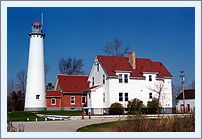|
Historical Information

At the middle of the nineteenth century, the curving hook of Ottawa
Point had long formed a natural shelter for Tawas Bay, and was
frequently used as a harbor of refuge for vessels escaping squalls out
on Lake Huron. With the end of the Point difficult to discern at night
or in inclement weather, a grass-roots lobbying campaign pleaded to
Stephen Pleasonton, the Fifth Auditor of the Treasury, for the erection
of a lighthouse to guide vessels past Ottawa Point and into Tawas Bay.
Apparently Pleasonton looked upon the project with favor, as on his
recommendation, Congress appropriated $5,000 for the construction of a
Light on Ottawa Point in September 28, 1850.
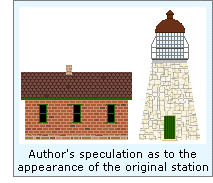 Construction at the Point began early
in 1852, and continued through the remainder of the summer and into the
fall. Since no photograph of this early tower have surfaced, it's exact
appearance is uncertain. However, we do know that the tower walls were
built of solid rubble stone masonry, and stood 45 feet in height from
grade level to the center of an array of Lewis lamps equipped with
silvered reflectors. By virtue of the tower's construction on elevated
ground, the Light sat at a focal plane of 54 feet above lake level and
approximately twenty feet from the diminutive 1½-story brick Keeper's
dwelling. Construction came to a close in October 1852, and with the
work completed so late in the year, the decision was made not to exhibit
the light until the following spring. Sherman Wheeler was appointed as
the station's first Keeper, and arriving at Ottawa Point late that
winter, exhibited the new Light for the first on the opening of the 1853
season of navigation. The tower and dwelling were the first permanent
structures to be built on Tawas Bay, with log cabins being the only
other structures in the area. Construction at the Point began early
in 1852, and continued through the remainder of the summer and into the
fall. Since no photograph of this early tower have surfaced, it's exact
appearance is uncertain. However, we do know that the tower walls were
built of solid rubble stone masonry, and stood 45 feet in height from
grade level to the center of an array of Lewis lamps equipped with
silvered reflectors. By virtue of the tower's construction on elevated
ground, the Light sat at a focal plane of 54 feet above lake level and
approximately twenty feet from the diminutive 1½-story brick Keeper's
dwelling. Construction came to a close in October 1852, and with the
work completed so late in the year, the decision was made not to exhibit
the light until the following spring. Sherman Wheeler was appointed as
the station's first Keeper, and arriving at Ottawa Point late that
winter, exhibited the new Light for the first on the opening of the 1853
season of navigation. The tower and dwelling were the first permanent
structures to be built on Tawas Bay, with log cabins being the only
other structures in the area.
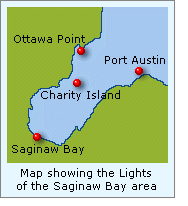 In the early 1850's a cry arose in the
maritime community, voicing concern over Pleasonton's tight-fisted
administration of the nation's aids to navigation. A clerical
administrator, Pleasonton had no maritime experience, and it showed-up
in the sub standard workmanship and poorly chosen locations of many of
the lighthouses erected under his administration. A study commissioned
by Congress recommended the establishment of a nine-member Board to
oversee the administration of aids to navigation. Staffed with Navy
officers and Engineers from the Army Corps of Engineers, the Lighthouse
Board was established in 1852, relieving Pleasonton from any further
involvement. One of the Board's first orders of priority was the
upgrading of illumination systems from the dim and poorly performing
Lewis Lamps to the far more efficient and powerful Fresnel lenses
manufactured in Paris. To this end, the Lewis lamps were removed from
the Ottawa Point Light in 1856, and replaced with a rotating Fifth Order
Fresnel lens. This lens was designed to exhibit a characteristic fixed
white light with a red flash every ninety seconds. To impart the desired
characteristic, the lens was outfitted with a red bulls eye panel and
was situated atop a cast iron pedestal and equipped with a set of wheels
known as a chariot . A clockwork motor rotated the lens around the lamp
at an exact rotational speed which placed the bulls eyes between the
mariner and the lamp every minute and a half, thereby creating a bright
red flash which permeated the constant white light. In the early 1850's a cry arose in the
maritime community, voicing concern over Pleasonton's tight-fisted
administration of the nation's aids to navigation. A clerical
administrator, Pleasonton had no maritime experience, and it showed-up
in the sub standard workmanship and poorly chosen locations of many of
the lighthouses erected under his administration. A study commissioned
by Congress recommended the establishment of a nine-member Board to
oversee the administration of aids to navigation. Staffed with Navy
officers and Engineers from the Army Corps of Engineers, the Lighthouse
Board was established in 1852, relieving Pleasonton from any further
involvement. One of the Board's first orders of priority was the
upgrading of illumination systems from the dim and poorly performing
Lewis Lamps to the far more efficient and powerful Fresnel lenses
manufactured in Paris. To this end, the Lewis lamps were removed from
the Ottawa Point Light in 1856, and replaced with a rotating Fifth Order
Fresnel lens. This lens was designed to exhibit a characteristic fixed
white light with a red flash every ninety seconds. To impart the desired
characteristic, the lens was outfitted with a red bulls eye panel and
was situated atop a cast iron pedestal and equipped with a set of wheels
known as a chariot . A clockwork motor rotated the lens around the lamp
at an exact rotational speed which placed the bulls eyes between the
mariner and the lamp every minute and a half, thereby creating a bright
red flash which permeated the constant white light.
By 1867, a mere fourteen years after
the station's completion, the Eleventh District Inspector reported that
the pointing between the rubble stones in the tower was falling out, and
that the lantern had deteriorated to the point that water was leaking
into the tower interior, damaging the wooden stairs and leaving the
interior walls in constant state of dampness. He also reported that the
kitchen floor in the dwelling needed replacement, and that a water
supply for the keeper was necessary. However, beyond making minor
"Band-Aid" repairs, the Lighthouse Board elected not to seek
the funds necessary for properly repairing the structures, as it
realized it had problems of significantly higher magnitude to solve on
Ottawa Point.
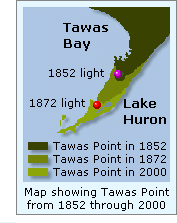 By virtue of the prevailing Northeast
wind, Ottawa Point had forever been in a state of evolution. Driven by
wave and wind, sand from the lake-bed and the shoreline was continually
deposited onto the end of the Point, changing its configuration. Over
the years since the construction of the Light, this natural reshaping
had continued unabated, lengthening the Point by almost a mile, and
leaving the old lighthouse "high and dry," three quarters of a
mile from the end of the point it was designed to mark. Additionally,
the light had a reputation among mariners as being extremely dim and
difficult to see from out in the Lake. The combination of the dimness of
the light and its distance from the Point represented a disaster waiting
to happen. By virtue of the prevailing Northeast
wind, Ottawa Point had forever been in a state of evolution. Driven by
wave and wind, sand from the lake-bed and the shoreline was continually
deposited onto the end of the Point, changing its configuration. Over
the years since the construction of the Light, this natural reshaping
had continued unabated, lengthening the Point by almost a mile, and
leaving the old lighthouse "high and dry," three quarters of a
mile from the end of the point it was designed to mark. Additionally,
the light had a reputation among mariners as being extremely dim and
difficult to see from out in the Lake. The combination of the dimness of
the light and its distance from the Point represented a disaster waiting
to happen.
 That disaster came when Captain
Olmstead ran his schooner "Dolphin" aground on the Point
beyond the lighthouse during a heavy Southeast gale. Olmstead openly
blamed the "faint flicker" of the lighthouse for the accident,
a cry that was picked up by H. E. Hoard, the editor of the Iosco County
Gazette a few weeks later. In one of his reports on the incident, Hoard
claimed that "this is not the first instance where our feeble
Lighthouse out in the country has proved a snare, instead of a guide." He continued; "Nature has favored us with one of the
best harbors on the lakes, and it would seem that the small amount
necessary to make it safe and easy access, might be appropriated by our
Government, especially when such immense sums are being expended in
other places to build up Harbors of Refuge, Life Saving Stations, etc.,
etc." That disaster came when Captain
Olmstead ran his schooner "Dolphin" aground on the Point
beyond the lighthouse during a heavy Southeast gale. Olmstead openly
blamed the "faint flicker" of the lighthouse for the accident,
a cry that was picked up by H. E. Hoard, the editor of the Iosco County
Gazette a few weeks later. In one of his reports on the incident, Hoard
claimed that "this is not the first instance where our feeble
Lighthouse out in the country has proved a snare, instead of a guide." He continued; "Nature has favored us with one of the
best harbors on the lakes, and it would seem that the small amount
necessary to make it safe and easy access, might be appropriated by our
Government, especially when such immense sums are being expended in
other places to build up Harbors of Refuge, Life Saving Stations, etc.,
etc."
Evidently the combination of the
Lighthouse Board's recommendation, Editor Hoard's protestations, and
added impetus from Michigan's State Representatives made the necessary
impression, with Congress appropriating the sun of $30,000 for the
erection of a new light station during its 1875 session. Eleventh
District Engineer Major Godfrey Weitzel selected a site for the new
station later that year, and drew up plans and specifications for the
station's construction that winter. Title for the site was obtained in
the summer of 1876, and with the delivery of a work crew and materials
to Ottawa Point on August 12, work began at a feverish pace.
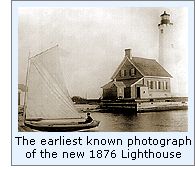 As time had proven, the shifting sands
of the entire point created an unsuitable location for a tall tower, and
in order to create a stable base on which the structure could be
erected, an area at the end of the Point was shored-up with a timber
crib. Within this cribwork, timber piles were driven to provide a secure
base on which a circular foundation of cut limestone foundation blocks
were laid. Atop this foundation, a team of masons erected the brick
tower. Standing sixteen feet in diameter at its base, the walls tapered
gracefully to a diameter of nine feet six inches at their uppermost.
Supported by twelve gracefully curved corbels, a copper-clad gallery was
installed and encircled by an iron safety railing. As time had proven, the shifting sands
of the entire point created an unsuitable location for a tall tower, and
in order to create a stable base on which the structure could be
erected, an area at the end of the Point was shored-up with a timber
crib. Within this cribwork, timber piles were driven to provide a secure
base on which a circular foundation of cut limestone foundation blocks
were laid. Atop this foundation, a team of masons erected the brick
tower. Standing sixteen feet in diameter at its base, the walls tapered
gracefully to a diameter of nine feet six inches at their uppermost.
Supported by twelve gracefully curved corbels, a copper-clad gallery was
installed and encircled by an iron safety railing.
A decagonal cast iron lantern was
erected at the center of the gallery, and covered with a tapered copper
roof with ventilator ball, standing sixty-seven feet above grade level.
A lightning rod atop the ventilator ball was attached to a copper cable,
which lead down the outside of the brickwork to a ground stake driven
alongside the foundation. A spiral cast iron staircase with three
landings wound its way within the tower to a hatchway through the
keepers could gain access to the lantern. The 1½ story brick dwelling
was built over a stone-walled cellar, and attached to the tower by a
covered passageway to provide the Keeper access to the tower without
having to leave the warmth of the building during inclement weather. A
cast iron door at the tower end of the passageway was installed to stem
the spread of a possible fire between the two structures. Finally, the
entire crib structure was covered-over with a plank deck to allow the
Keepers easy footing when moving around the station.
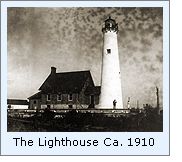 Construction was completed as winter
cast its icy grip across Tawas bay, and with the weather too cold to
allow the painting of the tower exterior, and the end of the navigation
season close at hand, the decision was made to postpone exhibiting the
light until the arrival of spring. That winter, the Fifth Order Fresnel
was removed from the old tower, and carefully installed in the new
tower. By virtue of the tower's location atop the cribbed area, the lens
now sat at a focal plane of 70 feet. With the break-up of ice on the
lake. Keeper James Harald climbed to the lantern to exhibit the light in
the new station for the first time on an unrecorded date at the opening
of the 1877 season of navigation. Construction was completed as winter
cast its icy grip across Tawas bay, and with the weather too cold to
allow the painting of the tower exterior, and the end of the navigation
season close at hand, the decision was made to postpone exhibiting the
light until the arrival of spring. That winter, the Fifth Order Fresnel
was removed from the old tower, and carefully installed in the new
tower. By virtue of the tower's location atop the cribbed area, the lens
now sat at a focal plane of 70 feet. With the break-up of ice on the
lake. Keeper James Harald climbed to the lantern to exhibit the light in
the new station for the first time on an unrecorded date at the opening
of the 1877 season of navigation.
In September 1875, an additional crib
protection 130 feet in length and 10 feet in width was erected to a
height of four feet above the lake level at the northwest corner of the
existing crib around the station. This cribwork was filled with
materials removed from the old 1853 tower and dwelling, which had been
demolished after the new station was established.
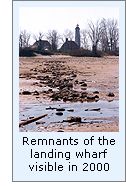 The deck on the crib was replaced in
1890, and with dropping lake levels exposing an ever increasing expanse
of beach around the Point, the landing wharf at the rear of the station
in Tawas Bay was extended 600 feet to reach the three foot water depth.
Also this year, as a result of recurring problems with keeping the
light's rotational speed timed accurately, the District Lampist was
dispatched to the station to inspect the lens rotating mechanisms. While
the Lampist made some adjustments to the chariot at the base of the
lens, the problem was evidently of a nature beyond that which could be
repaired in the field. With the Ottawa Point Light becoming increasingly
important as a guide to mariners coasting the western shore, the
decision was made to both upgrade the lens to one of the Fourth Order
and to modify the characteristic to increase the light's overall
effectiveness. The deck on the crib was replaced in
1890, and with dropping lake levels exposing an ever increasing expanse
of beach around the Point, the landing wharf at the rear of the station
in Tawas Bay was extended 600 feet to reach the three foot water depth.
Also this year, as a result of recurring problems with keeping the
light's rotational speed timed accurately, the District Lampist was
dispatched to the station to inspect the lens rotating mechanisms. While
the Lampist made some adjustments to the chariot at the base of the
lens, the problem was evidently of a nature beyond that which could be
repaired in the field. With the Ottawa Point Light becoming increasingly
important as a guide to mariners coasting the western shore, the
decision was made to both upgrade the lens to one of the Fourth Order
and to modify the characteristic to increase the light's overall
effectiveness.
The new Fourth Order lens was ordered
from Paris, and after receipt at the Detroit depot during the summer of
1891, the District Lampist was again dispatched to Ottawa Point to
undertake the installation. The new lens was officially exhibited for
the first time on the night of September 1, 1891, with its new
characteristic of a repeated 30 second cycle, consisting of fixed white
light for 25 seconds followed by a 5 second eclipse, visible for a
distance of 16 miles.
1896 again saw the rebuilding of the
timber platform around the tower and dwelling, and the beginning of a
second extension to the landing wharf at the rear of the station, which
on its completion in 1897, lengthened the wharf by an additional 640
feet.
When the new station was built in 1876,
lard and sperm oil ware used for fueling the lamp. Relatively
non-volatile, the oil was stored in a purpose-built room in the dwelling
cellar. With a change to the significantly more volatile kerosene, a
number of devastating dwelling fires were experienced, and beginning
late in the 1880's the Lighthouse Board embarked upon a program of
erecting separate oil storage buildings at all US light stations. To
this end, a brick oil storage house was built in 1898, six of the timber
cribs supporting the wharf were rebuilt, and the boathouse was rebuilt
at the end of the extended wharf.
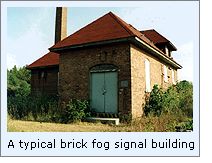 As part of a continuing project to
create a network of fog signal stations at lighthouses throughout the
nation, the lighthouse tender AMARANTH arrived at Ottawa Point in the
summer of 1899, and unloaded a working party and materials for the
construction of a brick fog signal building on the Point. Work continued
through the summer, and the single 10-inch steam whistle was placed into
operation on September 28. As was the case with the lighthouse itself, a
timber crib was erected around the fog signal building to both stabilize
the foundation and to prevent the surrounding sands from being washed
away. A boardwalk was laid between the tower and the fog signal, a
telephone system was installed between the dwelling and the fog signal
building, and a new landing dock was erected 1,200 feet to the west of
the fog signal building. Designed for the delivery of coal for the
boilers, a tramway was laid from the new landing dock to the fog signal
building to facilitate the movement of coal from the visiting lighthouse
supply vessels to the bunker in the fog signal building. As part of a continuing project to
create a network of fog signal stations at lighthouses throughout the
nation, the lighthouse tender AMARANTH arrived at Ottawa Point in the
summer of 1899, and unloaded a working party and materials for the
construction of a brick fog signal building on the Point. Work continued
through the summer, and the single 10-inch steam whistle was placed into
operation on September 28. As was the case with the lighthouse itself, a
timber crib was erected around the fog signal building to both stabilize
the foundation and to prevent the surrounding sands from being washed
away. A boardwalk was laid between the tower and the fog signal, a
telephone system was installed between the dwelling and the fog signal
building, and a new landing dock was erected 1,200 feet to the west of
the fog signal building. Designed for the delivery of coal for the
boilers, a tramway was laid from the new landing dock to the fog signal
building to facilitate the movement of coal from the visiting lighthouse
supply vessels to the bunker in the fog signal building.
With the increased workload represented
by the fog signal, the Detroit office determined that the station would
need an Assistant Keeper. However, realizing that the diminutive
dwelling was too small for a second keeper and his family, the
Lighthouse Board requested an appropriation of $5,000 for the
construction of a second dwelling in its annual reports for 1900. George
Galbraeth was appointed as the station's first Assistant on March 16,
1900, and since no arrangements had been made for living accommodations,
we can only surmise that he must have moved into one of the rooms in the
main dwelling. Evidently, Galbraeth was not too enamored with the living
arrangements, as he resigned from lighthouse service on January 31 of
the following year, after less than a year's service. Edward L Sinclair
took over for Galbraeth after transferring-in from Huron Island, where
he had served as Second Assistant for three years.
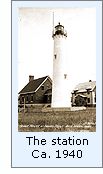 After the Board's annual pleas for
funding to construct a second dwelling went ignored for five years,
Eleventh District Inspector Commander Herbert Winslow insisted that
arrangements be made for a dwelling for the Assistant, and in 1905 an
abandoned boathouse on the Point was patched-up and converted into a
temporary dwelling for the Assistant Keeper. In a further attempt to
stem erosion, brush and stone revetments were built along the lakeshore
in the vicinity of the fog signal building, and 1,300 willow trees were
planted. The following year, a barn was built, 23 cribs were
reconstructed, and the walks connecting the station with the fog signal
were replaced with concrete slabs which were poured at the Detroit depot
and transported to the site. After the Board's annual pleas for
funding to construct a second dwelling went ignored for five years,
Eleventh District Inspector Commander Herbert Winslow insisted that
arrangements be made for a dwelling for the Assistant, and in 1905 an
abandoned boathouse on the Point was patched-up and converted into a
temporary dwelling for the Assistant Keeper. In a further attempt to
stem erosion, brush and stone revetments were built along the lakeshore
in the vicinity of the fog signal building, and 1,300 willow trees were
planted. The following year, a barn was built, 23 cribs were
reconstructed, and the walks connecting the station with the fog signal
were replaced with concrete slabs which were poured at the Detroit depot
and transported to the site.
Finally in 1922, an existing house in
town was purchased as an Assistant's dwelling, moved to the station, and
erected on a foundation to the north of the tower. Three years later, on
October 27 1925, the 10-inch steam whistle and boilers were removed from
the fog signal building and replaced by a Type F Diaphone signal, and
the characteristic changed to a repeated 60-second cycle consisting of a
blast of 4 seconds, 16 seconds of silence, a second blast of 4 seconds
followed by 36-seconds of silence.
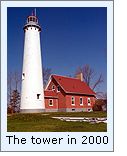 Nature continued to have her way on the
sandy hook of Tawas Point, and the Point continued on its inexorable
growth into Tawas Bay. The elevated timber crib on which the station was
erected was replaced by concrete walls, and the entire area was
graded-over with soil and planted with grass. While the concrete walls
were only visible in a few places, the location of the crib remained
clearly evident as a rectangular raised area on the lawn. By the 1950's, the lighthouse once again stood
too far inland to serve as anything but a coast light. However, with the
introduction of radar and radio, mariners no longer relied as heavily on
the Light, and the tower now served more as a historical artifact than
as a structure of high navigational significance. Thus, the station was
automated and closed in 1953. Keeper Leon DeRosia, who had tended the
Light for the past six years, accepted a transfer to Grays Reef and
departed for his new assignment on Lake Michigan, making him the last
Keeper of the Ottawa Point Light. Nature continued to have her way on the
sandy hook of Tawas Point, and the Point continued on its inexorable
growth into Tawas Bay. The elevated timber crib on which the station was
erected was replaced by concrete walls, and the entire area was
graded-over with soil and planted with grass. While the concrete walls
were only visible in a few places, the location of the crib remained
clearly evident as a rectangular raised area on the lawn. By the 1950's, the lighthouse once again stood
too far inland to serve as anything but a coast light. However, with the
introduction of radar and radio, mariners no longer relied as heavily on
the Light, and the tower now served more as a historical artifact than
as a structure of high navigational significance. Thus, the station was
automated and closed in 1953. Keeper Leon DeRosia, who had tended the
Light for the past six years, accepted a transfer to Grays Reef and
departed for his new assignment on Lake Michigan, making him the last
Keeper of the Ottawa Point Light.
 The Coast Guard announced plans to
excess the station in 1996, and ownership of the buildings was
transferred to the Michigan Department of Natural Resources in 2001.
Deciding that it wished to restore the station to its turn of the
twentieth century appearance, in May 2002, the DNR took the
controversial step of demolishing the 1922 Assistant's dwelling. Over
the remainder of the year, over 3 million dollars were spent at the
site, including such improvements as the burial of elevated power lines,
the installation of a new red-painted steel roof on the dwelling and the
installation of flood
lights to illuminate the
tower at night. The Coast Guard announced plans to
excess the station in 1996, and ownership of the buildings was
transferred to the Michigan Department of Natural Resources in 2001.
Deciding that it wished to restore the station to its turn of the
twentieth century appearance, in May 2002, the DNR took the
controversial step of demolishing the 1922 Assistant's dwelling. Over
the remainder of the year, over 3 million dollars were spent at the
site, including such improvements as the burial of elevated power lines,
the installation of a new red-painted steel roof on the dwelling and the
installation of flood
lights to illuminate the
tower at night.
In a rededication ceremony on October 8, DNR Director K
L Cool flipped the switch which light up the tower exterior. The DNR has
plans to completely restore the interior of the tower and dwelling, and
we hope that within the next couple of years the entire structure will
again be open, and the public will again be able to climb the tower to
take in the magnificent view it affords.

Keepers of
this Light

Click here
to see a complete listing of all Tawas Light keepers compiled by Phyllis
L. Tag of Great Lakes Lighthouse Research.

Finding this
Light

Travel northeast from East Tawas on US-23 to Tawas Beach Road. Turn
right on Tawas Beach Road and travel approximately 2-3/4 miles to the
Tawas Point State Park entrance. A motor vehicle permit is required for
entry into the park.
The tower is open to the public From May 15 through October 15 on
Saturdays, Sundays and Holidays.

Contact
Information

Tours can be arranged by contacting (989) 362-5041

Reference
Sources

 Inventory of Historic
Light Stations, National Parks Service, 1994 Inventory of Historic
Light Stations, National Parks Service, 1994
Around The Bay, Neil Thornton, Printers Devil Press.
The Detroit News, September 10, 1998
USCG Historian's Office -
photographic archives.
Tawas Point Light, pamphlet, Robert J. Cichocki, USCG Auxiliary
Historian
Photographs from the Neil Thornton collection.
Personal observation at Tawas Point, 05/06/2000
Photographs from the author's personal collection.
Keeper listings for this light appear courtesy of Great
Lakes Lighthouse Research
|
